Justice, of a Kind, For MH17
November 19, 2022
LAST WEEK, a court in Holland found three men responsible for the downing of Malaysia Airlines flight MH17 eight years ago.
Back in 2014, operating in eastern Ukraine, they were part of a separatist group under Russian control, responsible for firing the “Buk” rocket that struck the Boeing 777 at 33,000 feet during a flight from Amsterdam to Kuala Lumpur. Cruising just above restricted commercial airspace, the plane had been misidentified as a military target. The men — Igor Firkin, Sergei Dubinsky, and Leonid Kharchenko — were found guilty in absentia and sentenced to life. Currently free and living in Russia, it’s unlikely they ever will serve time.
MH17 was carrying 298 people from 17 countries, including 80 children. That ghastly total puts MH17 at number seven among the deadliest air disasters of all time. In the Netherlands, where 196 of the victims lived, the catastrophe was and remains front-page news. Strangely, the rest of the world seems to have forgotten about it. It never stayed in the headlines for especially long, and shortly thereafter it ceased to be much of a topic, even in aviation circles. It’s peculiar how many lesser disasters, even those that occurred decades ago, are fresher in our minds. Ask a pilot about MH17 and you’re liable to get a blank stare. “Which one was that?”
Is that a symptom of our diminished attention spans, or something else? Maybe it was the certain-ness of the accident, and the ugly brutality of it. Unlike many crashes, there was no mystery or mystique surrounding this one. From the very first day it was clear what had happened, and it was pretty grotesque.
It’s also true that Malaysia Airlines had already earned its fifteen minutes of infamy. It’s the carrier’s other major mishap, earlier that same year, that is more widely remembered and discussed. That’d be MH370, of course, the vanished 777, only a few parts of which have ever been found, washed up on beaches on Mauritius and Reunion islands. That one gets people talking, albeit nonsensically much of the time.
MH17 wasn’t the first commercial jet downed by the Russians. Many of you will remember the tragedy of Korean Air Lines flight 007 in 1983. The Boeing 747 was on a flight from New York to Seoul when it strayed off course and was blown up by a Soviet fighter jet. The worldwide outrage the followed was a lot more intense than anything stoked by MH17.
Ditto after the U.S. Navy cruiser Vincennes accidentally shot down an Iran Air jetliner in July, 1988, killing 290 people.
The Iran Air incident sits at number eight on that list of deadliest disasters. KAL 007 was, until 2014, the tenth worst, nudged to number eleven by MH17. This means that three of history’s eleven worst crashes were planes brought down by missiles. Add in Lockerbie (number 10), plus the 1985 Air India bombing (number 5), and five of the worst eleven — nearly half — were either missiles or bombs.
It’s not entirely fair, lumping those together. The bombings were deliberate; the shoot-downs were cases of mistaken identity. We will save for later the bigger and deeper conversation over what does or doesn’t constitute an “accident,” and the sticky applications of culpability. MH17, Iran Air, KAL 007; each of these involved a certain amount of recklessness. At what point, though, does an error become criminal?
And this isn’t the first time someone has been convicted in absentia for destroying a commercial plane. In 1999, a court in Paris found six Libyans guilty for the bombing of UTA flight 772 ten years earlier, including the brother-in-law of Moammar Khadafy. None of the six stood trial. The explosion, over a remote part of the Sahara, killed 170 people. A U.S. judge later ordered Libya to pay $6 billion in damages on behalf of seven Americans who’d been on board.
Some of my U.S. readers have asked why the Malaysia Airlines flights are always referred to alpha-numerically: MH17 and MH370. Most Americans don’t realize that flight numbers are prefixed by a two-character airline code. The code for Malaysia Airlines is MH. In the United States we normally drop these prefixes, but they are used routinely elsewhere. This is discussed in more detail in chapter seven of my book.
And the name of the airline is Malaysia Airlines. It’s not “Malaysian Airlines,” and certainly not “Malaysian Air.”
Malaysia Airlines was formed in the early 1970s after its predecessor, Malaysia-Singapore Airlines (MSA), split to become Singapore Airlines and Malaysia Airlines. Both carriers are renowned for their outstanding service, and cabin crews of both airlines wear the iconic, floral-pattern “Sarong Kabaya” batik — an adaptation of the traditional Malay kebaya blouse.
Malaysia Airlines’ logo, pictured above, is an indigenous kite known as the Wau. True story: In 1993 I was in the city of Kota Bahru, a conservative Islamic town in northern Malaysia close to the Thai border, when we saw a group of little kids flying Wau kites. At the time I didn’t realize where the airline’s logo had come from, but I recognized the pattern immediately. It was one of those airline/culture crossover moments that we aerophiles really savor.
Related Stories:
DISASTER OVER TEHRAN
PERMANENT MYSTERY. MH370, EIGHT YEARS ON.





